Dale Carnegie said: “When dealing with people, remember you are not dealing with creatures of logic, but with creatures of emotion.” Try applying this truism to the classic mystery, and you can perhaps see why some people turn away from the tendency of these stories to shortchange the emotional aspects of murder, while others are drawn to the emphasis on puzzle out of 1) a desire to exercise their own little grey cells, or 2) a need to put aside the emotional maelstrom of the real world and reside in a more ordered, less messy society for a few hours.
While it’s true that most of the old classics appeal to the brain and tend to minimize matters of the heart, even the most puzzle-oriented of authors occasionally slip in something that tugs at your heartstrings. In truth, I’m an old softie, so it’s no surprise that I’m drawn to those titles and that many of them have found their way to the top of my favorites lists.

Of great interest to me was that as I was compiling a list of books that fit this category, I noted that almost every one of them was written in the 1940’s, specifically during the final stages and aftermath of World War II. Not all of them address the war directly – some not at all – but it seems highly likely that living through this international cataclysm had a profound effect on these writers. It made me wonder if I should be focusing my talents on the SilverAge, where the psychological element began to crowd out the pure puzzle. Yet all of the authors on my list were definitely Golden Age authors, and most of them were, first and foremost, puzzle crafters throughout their lengthy, prolific careers.
Perhaps the fact that my tastes coincide with this historical time is just that – a coincidence. At any rate, while I know many of my readers and blogging friends prefer their crime stories free of sentiment, for the rest of you, I thought I would offer a signpost draped in flowers of books by my four favorite authors that mystified me in that good ol’ GAD way andmoved me in the mysterious ways that the best of writers do.
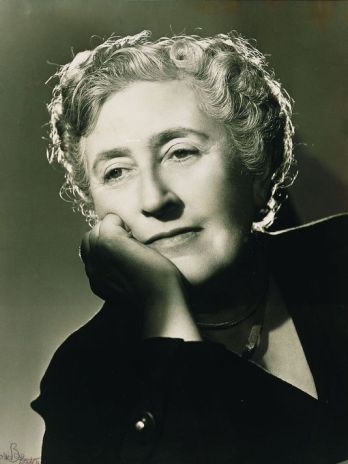
Agatha Christie and The Artist’s Gaze
I’ve been reading Christie for fifty years. With two exceptions (Passenger to Frankfurt and Postern of Fate), I’ve read every book at least twice and most of them 3 – 6 times. I more than love Agatha Christie; I’ve made a study of her. Yet it has taken me many years of living my own life to find the depth of emotion in her writing.
As a plotter, she is ruthless. Patricia Wentworth’s Miss Silver may live to bring young lovers together; Christie is never afraid to tear them asunder. Much of her ability to surprise comes from her willingness to make anybody the killer. But rarely does the moment come after the killer has been unmasked that everybody’s life falls apart. Husbands and wives lose each other, parents their children and vice versa. Christie quickly cleans up the emotional mess (the bereaved lover has another admirer waiting in the wings; the grieving parent will soon die of cancer and suffer no more) or avoids it altogether by keeping the unhappiest person offstage and mentioned only in passing, if at all.
This was definitely the case through the first two decades of Christie’s career. But the second world war shook her up, and her keen understanding that the genre was changing loosened her up a bit. Plus, as Christie got older, her characters got more reflective so that by the 1960’s there was an air of melancholy behind much of her plotting.
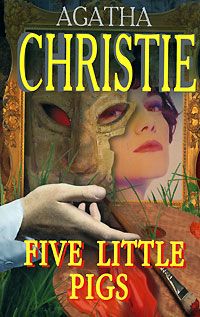
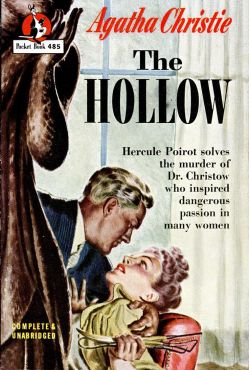
Sometimes, Christie’s tapping into the emotional scene surrounding murder led to greatness, no more so than in a pair of novels from the 1940’s that mirror each other in a way due to their similar preoccupation with art, fame, and greatness. The victims in Five Little Pigs (1942) and The Hollow (1946) (two books I have covered at great length in this space before – but then I love talking about them) are both passionate men. Painter Amyas Crale and Doctor John Cristow have achieved great things in their work but also in their personal lives: Amyas has a thriving career as a renowned painter and still finds time for a wife who is both beautiful and tempestuous, a baby daughter, a gorgeous, willful mistress, an adolescent sister-in-law, and a pair of friends dating back to his boyhood. John is on the cusp of finding a cure for a terrible disease as he still balances an adoring wife and not one but two mistresses. If there is a greatness about them, something larger than life, they are also both great big jerks – giving generously of themselves in their work and conversely selfish in their emotional and physical needs.
Still, it’s not a great surprise that both end up dead, and their murders are not what pull at our emotions. It’s the lives of the people around them, all more deeply affected by the crime than is usual for Christie and all moved by their emotions into action. In Pigs, it is mostly time and the failing powers of memory that create barriers for Hercule Poirot in his quest to prove whether or not Caroline Crale murdered her husband, a crime she did not deny committing until after her conviction, and then only privately. In The Hollow, an entire family comes together to cause confusion to Poirot in an attempt to protect one of their own.

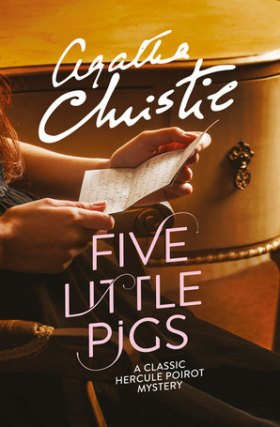
Despite the obstacles of the murder in retrospect or the murder where everybody lies, Poirot reaches the truth in both cases, and this is where Christie succeeds in on an emotional basis. In one case, the unmasking of the killer reveals the shattering loss that the act of murder has wrought on the culprit. In the other, the solution may carry emotional heft, but the real impact occurs afterward to one particular survivor of the events, revealing the shattering power of Art itself to both wound and heal.
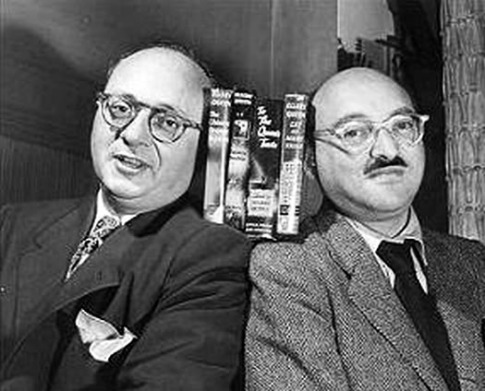
Ellery Queen and the Humanization of a Detective
Much has been said of the distinct periods in the life of the fictional Ellery Queen. The changes in the character’s very nature and in the focus of his cases came about as authors Frederick Dannay and Manfred B. Lee followed the trends of popular culture and pursued certain thematic ideas close to their hearts. We speak of three distinct periods, but really there were many incarnations of Ellery Queen, all of them different, if you take into account the fellow you meet in the movies, on the radio, and on television.

The difference between Literary Queens #1 and #2 came about gradually after the publication ofThe Spanish Cape Mystery (1935) and was largely affected by the creators’ desire to appeal to the readers of women’s magazines. So, while the 1936 title Halfway House could have been called The Swedish Match Mystery, the authors began to move away from a coldly intellectual puzzle (the ubiquitous “Challenge to the Reader” was dropped here) and softened Ellery from a pompous decipherer of clues to a more humane individual. Each of the subsequent Period Two novels chipped away further at Ellery’s shell; the only problem was that for much of this period, particularly when Ellery is working in Hollywood, the mysteries themselves suffer and the characterization is not sufficient enough to compensate.
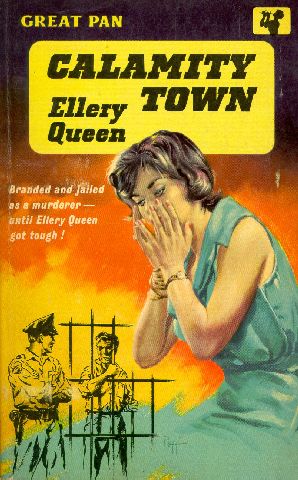
Then the U.S. entered World War II, and Ellery made his first trip to Wrightsville. This marked a rebirth for the detective. In 1942, three years had passed since the publication of The Dragon’s Teeth, arguably one of the weakest Queens ever written. If it also represents a mystery written by the fictional Ellery Queen, one can understand why the character wanted a change of scene to work on his next novel. What he found was a small New England town, reminiscent of Grover’s Corners, New Hampshire, the setting for Thornton Wilder’s Pulitzer Prize-winning 1938 play, Our Town. Both locations share a large cast of characters and a sense that for generations, everything changes and yet stays the same. In Calamity Town, the winds of war are beginning to stir greater change in the people of Wrightsville, but all Ellery sees is a bucolic haven from the frantic pace of the city and the weary grind of crime-solving – in short, a perfect getaway in which to write.
If only Ellery had read his Miss Marple, he could have been reminded that bucolic villages are in reality cesspools of sin. Either that, or Ellery was indeed a magnet for crime, since every single visit he would make to Wrightsville, over the course of many novels and short stories, would engender major crimes and emotional turmoil.
Calamity Town marked a change to the detective and to the tone and complexity of his cases that was in no way subtle. Perhaps this is why Period Three has such clear adherents and equally certain detractors, who miss the acrostic-like nature of the “nationality + noun” mysteries of Period One. There is no doubt that this novel, and the Wrightsville-set sequel that follows, 1945’s The Murderer Is a Fox, lack the chess moves and multiple false endings of your Greek Coffin or Egyptian Cross mysteries. What they lack in clues, they make up for in complex characters, novelistic themes, and emotional heft. 1948’s Ten Days Wonder returns to a trickier pace but is balanced by a grand wallop of an idea, one that Dannay and Lee would explore for the rest of their writing career. It is my least favorite of the Wrightsville novels, but it is important for the effect the case has on Ellery and for how it leads into his return to Gotham and to the authors’ magnum opus, Cat of Many Tails (1949). This novel brings New York to life as no other Queen novel before it had done, in all its gritty, terrifying glory. The mystery is both intimate and epic, containing moments of true terror as a serial killer stalks the heat-plagued summer streets of the city, wreaking havoc with a seemingly patternless series of stranglings, sparking riots and bringing out the worst and best in the citizenry.

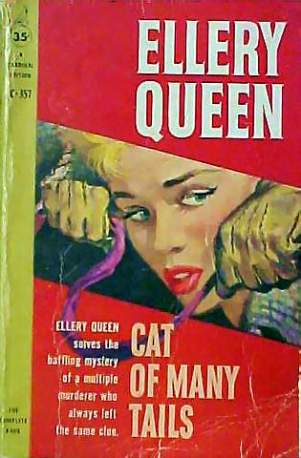
When it’s over, the mood feels anything but triumphant, and the novel provides a climax that began in 1942, when Ellery first arrived in Wrightsville on the pretext of writing a novel but, in reality, searching for . . . something. The finale of Catfinds the novelist/detective on the verge of losing everything. It would be a hard-hearted reader indeed who is not moved by the existential journey taken by this previously impervious fictional character over the course of these four novels.
(NB: In 1943, Queen’s publication of There Was an Old Woman interrupted this pattern. The novel is as screwball as a tale by Delano Ames or Kelley Roos. But evidence suggests it had been written earlier and reworked; possibly it was the very novel Queen was working on and had to abandon when Christie published And Then There Were Nonein 1939. I will say, however, that the trick ending does pack a punch, even if it is more of a smack compared to our emotional journeys through Wrightsville.

How John Dickson Carr Touched This Old Heart – Twice!
Sometimes an author can touch you not for what they are best known for but for the cumulative effect of a plot strand or the way a character is created. In Five Little Pigs, Christie doesn’t lavish many of her usual tricks of misdirection; it is one of her most straightforward plots, and yet it is also one of her best because of the way she digs into these people.
When I started reading mysteries at a tender age, John Dickson Carr quickly became my other favorite author because he was equally audacious in his desire to bamboozle us. Ellery Queen could do this too, but both men, at least in their early work, were so technical in their approach to the puzzle that the characters suffered, and our reactions, strong as they were, tended toward the intellectual rather than the emotional.
But as we’ve seen, the 1940’s brought changes to the approach or the interest or the focus of these authors. The difference between Carr and the others is that he never sacrificed the puzzle for more compelling focus on psychology. If the novelistic trappings of the writer couldn’t fit in to his primary plan to fool us, then Carr seemingly had little interest in padding his books to fit that stuff in.
On two occasions in the 1940’s Carr managed to fit it all in. Interestingly, these are both novels that I only read in the last couple of years, and I am the happier for it. Having the insight of a man who has lived some life rather than a boy at the very beginning of it has, I think, allowed me to better absorb the emotional impact of both these titles. And although the mechanism for this works differently in each work, both novels left me reeling in the best of ways.
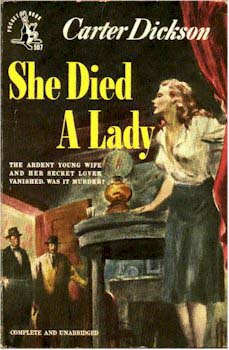
She Died a Lady, published in 1943 under Carr’s alias Carter Dickson, is narrated by Luke Croxley, the doctor in the small village of Lynmouth. He is old and on the verge of retirement, and he lives with his son whom he is proud to let take over his practice. As usual with a Sir Henry Merrivale mystery, the cast is small, and it centers on a romantic triangle between a gentle old man, his voluptuous wife, and the handsome actor with whom she is carrying on right under her husband’s nose.
The mystery that is presented is a fine one, full of impossibilities laid out on a richly drawn landscape. (That cliff . . . !) In the end, I would venture to say that Carr/Dickson bamboozles us but good! And the nature of that authorial rug-pulling can’t help but do an emotional number on all but the chilliest of us. In the vaguest of SPOILERS I can give, there are reliable narrators and unreliable narrators. Here we have a third kind, and Dr. Croxley proves to be as unforgettable as the chain of events he witnessed.

He Who Whispers (1946) is a different kettle of fish because its status as a puzzle stands on shakier ground. Check out the blogs of a wide variety of folks who admire or love Carr and you’ll see a pretty wide disparity on their opinions of this one. I think some of the antipathy focuses on the clueing. I don’t pay enough attention to this, and I also tend to find my focus blurring over any discussion about the technical aspects of an impossibility. I will also admit here that, although I didn’t catch onto the killer’s plan until it was explained, I identified the culprit pretty much immediately.
That said, this is one of those reads that socks you in the gut, and it all has to do with Carr’s handling of the central character, Fay Seton. Carr has played the game many times before as to whether a leading female character is good or evil, and we know he is willing to come down on any number of sides. Over the course of the novel, the depictions of Fay run the gamut from wronged innocent to a literal, blood-sucking vampire. The truth about Fay is a bombshell for its time and is sensitively handled by the author. What’s more, once the case is solved, Carr has some further matters to take care of. I love a novel where the last sentence truly matters. I was at work when I finished this one, and I remember putting down the book and desperately wishing I had someone of an understanding nature to talk to about this. That’s how hard this novel hits me, no matter how much you want to argue about the quality of the puzzle. (I liked that part just fine, too, but what do I know?)
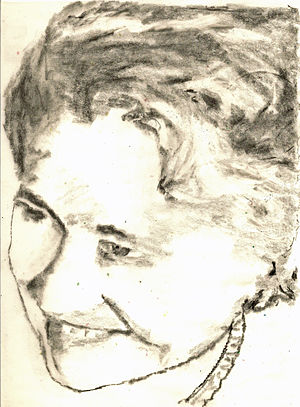
“Playing with the Queen of Hearts . . . “
I’ll announce this right here. Given how strongly I feel about Christianna Brand, I find it personally unconscionable that I have only read each of her mysteries once. I intend to do something about that, as soon as I can find a good affordable copy of Green for Danger. (I gave a lot of books away when I bought a house, to my infinite regret today.)
Nobody tugs at your heart like Brand does. Her novels are both humorous and filled with pathos. Her characters are never “types” but fully fleshed individuals (albeit mostly of the upper-class British variety). But Brand always takes the time to establish her milieu and the complex relationships between her closed circle. She doesn’t merely show us motives for murder. She also shows who people love and like and feel indifferent about. She makes us care about awkward people and find the good side to difficult folks. When somebody gets murdered, we rarely feel that perverse sense of all mystery readers that a sort of justice has been done. (Come on, was anybody actually rooting for Mrs. Boynton, or Marcus Chesney, or Cornelia Potts, or Mr. Shaitana?)


Because I’ve only read her novels once – and then quite a long time ago – I can’t remember enough details to talk with any authority about her books. But if there is anybody reading here who has not sampled her work, I want to point out that, in addition to the qualities I describe above, here are a few other things you can expect to find in her work:
- Brand excels at spreading suspicion around, at the same time manipulating us to imagine how horrible it would be if X, Y, or Z indeed turned out to be the killer. And even though she casts the net wide, in at least three cases (that I won’t name), she still manages to shock the hell out of us in the final reveal.
- In terms of clueing, Brand has no better in her ability to hide something revelatory in plain sight. How sorely I want to give you fifty examples now! (When I come to London in 2019, can we have a confab where we just talk about Brand??) I will give one example from Green for Danger, as vaguely as I can: Cast your mind back to the killer’s motive and how it rolls out. Part of the brilliance of this is the way characters’ inner mindsets are revealed. Christie also does this brilliantly. Am I confusing you? Go read the book!
- Few classic mystery authors waste much time showing how goddamn awful it is to be involved in a murder investigation. (It’s one of the reasons P.D. James dismissed the whole era with a sniff. I pity her!) This is not Brand. She portrays suspicion as a disease and Inspectors Cockrill or Charlesworth as a doctor trying to effect a cure. Much is made about “the restoration of order” at the end of a GAD detective novel. In a Brand story, you really feel this because she was so adept at depicting the emotional havoc that murder creates.

There are numerous other examples where mystery writers have ignored or bypassed the PFF law (“Puzzle First and Foremost”) to create works that touch our hearts. I was devastated at the end of Miss Pym Disposes by the futility of the main character’s actions as a result of her own hubris. I was deeply moved by the emotional arc of Peter and Iris Duluth’s stormy courtship and marriage throughout Patrick Quentin’s series about them. The love they feel for each other, even when they are torn apart, is a grand counterpoint to the wit that permeates the cases themselves. (This is another series I am re-collecting to re-read after many years.)

If you have favorites that moved you to a surprising depth of feeling, I would love to hear about them below.
I’m so glad you mentioned Christie’s Five Little Pigs and The Hollow, Brad. Both really do show depth of emotion that you wouldn’t think would be there at first glance. I’d also tentatively offer Sad Cypress, too. I agree about the way Ellery Queen developed as a character, and the later Queen mysteries. Some of them are much more than exercises in cerebral machination.
LikeLiked by 2 people
I tend to agree with you about Sad Cypress, Margot, but Elinor Carlisle is such an unlikable character initially that the emotional payoff comes quite late!
LikeLiked by 1 person
You have a point there, Brad – you really do.
LikeLike
In Sad Cypress, you can kind of feel for the victim Mary Gerrard, who comes across more as an innocent figure than she does in the 2003 film adaptation. Mary comes across more sympathetic than Elinor, don’t you think?
LikeLiked by 1 person
Well, not surprisingly my contributions to this idea will be books that you will be hard pressed to find. But here they are anyway :^D
CANDIDATE FOR LILIES by Roger East (an ending that speaks of true tragedy in the classical sense)
MURDER AMONG FRIENDS by Lange Lewis (one of the most profoundly moving motives for murder in any book from the Golden Age)
Any of the mysteries by Francis Duncan featuring Mordecai Tremaine. Duncan’s maturity in characterization rises above so many of his contemporaries. Particularly good at tugging the heartstrings is BEHOLD A FAIR WOMAN, but his masterpiece of a mystery is SO PRETTY A DEATH.
THE THIRD LADY by Shizuko Natsuki (thoroughly Japanese and a story that only makes sense in that culture. Achingly tragic.)
If you want to know more about any book in the list above, read my posts on each one at my blog. If I had to recommend only one of all the books I mentioned above, the one that packed the most powerfully emotional wallop then I would point you to MURDER AMONG FRIENDS by Lange Lewis. It is a book that really ought to be reprinted.
LikeLiked by 2 people
The problem here, John, is that you have piqued my curiosity and longing over books that I fear I will never find.
Is your blog site Murder Ahoy?
LikeLike
Wash mouth out! That’s Pretty Sinister John you’re talking to there….
LikeLiked by 1 person
Well, John is such a common name !
LikeLiked by 1 person
John, I read your reviews and did some searching. So Pretty a Problem is now in my Amazon queue, but I’m afraid I would need to refinance my home to afford the rare copies of Murder Among Friends. Ah well . . . someday, you’ll let me come over, sit in your garden and read your copy, yes? 🙂 (P.S. I don’t really care if there’s a garden!)
LikeLike
He has a fine terrace garden !
LikeLike
Good list Brad. Have to get my thinking cap on for which mystery novels do the same for me. Though in regards to your choices, I too was moved by Miss Pym Disposes but probably by different emotions lol
LikeLiked by 2 people
Yes, I remember all too well, Kate! At least we
Both have Freeman Wills Croft to ignore together!
LikeLike
One of these days, I’ll find you a Crofts book to love. One of these days…
LikeLike
Many really fine examples here all really support your thesis in my view – the Carr, Queen and Quentins I approve of especially. I would add the likes of Ross MacDonald and Raymond Chandler to the mix but perhaps we can save that conversation for another time 😀
LikeLiked by 1 person
Yeah, Sergio, I definitely have to bone up on those two before we can discuss!
LikeLike
Get to it chum 🙂 I would add some Sayers to your list, though I am far from being an adoring fan of Lord Peter.
LikeLiked by 1 person
Five Little Pigs is Christie’s greatest novel.
She manages to create some of the best realized characters in all of GAD with that book.Elsa Greer is a beautiful and fascinating study and Caroline and Amyas are her greatest couple in terms of development and character.She also is able to add in a amazing mystery with a stunning solution that very few will see coming.
Calamity Town will be my next Queen and my first from the Wrightsville Period,I’m hoping to follow it up with The Murderer is a Fox and then a very late period Queen.
I just finished Brand’s Green for Danger and I positively cried at the end of the book.
The culprit’s motive,reveal,and fate were all so emotionally well done and poignant and I felt devestated by the end.
But I’m even more devestated by this being my last Brand.I know that this could be slander,but she is my favorite detective novelist.She created ingenious puzzles and amazing characters which will stick with me forever.If I could wish for anything about GAD,I would wish for her to have published one last great detective novel featuring Cockrill.She is my favorite and I think she always will be.
LikeLiked by 2 people
I believe that something is coming down the pike, Beckie, in the not too distant future which will include works by Brand that have either not been published or not been collected before. My knowledge of it is vague, but I have been reading about it. It includes short stories and a novelette. Also, there is a novel that was never published. We all pray that some day it will be. I think it’s called The Chinese Puzzle.
You have good taste!
LikeLike
I love Five Little Pigs – it’s the best novel by her that I’ve read so far (I have quite a few to go). The ending was a real gut punch and it took me weeks to get it out of my head.
I agree with you on Green for Danger – what an emotionally stunning ending. You go into that last chapter thinking “I’m really curious to see who the killer is” and you’ve probably heavily considered everyone. By the conclusion of that chapter, you’re emotionally wrecked, which is something you never would have seen coming into it.
As for Brand being the greatest detective novelist – I wholeheartedly agree. If only she had written nearly as many novels as John Dickson Carr or Agatha Christie.
LikeLiked by 1 person
This is why I’m especially excited about (and committed to) re-reading her work. By the way, Ben, I have no idea why your comments ended up in my spam folder. Every technical thing I am connected to acts up constantly, and I have no idea how to fix any of it. Thanks for letting me know. I would have found you eventually! 🙂
LikeLike
I completely agree with your statement about her output.
If she had written as many books as Carr or Christie,she would have been considered one of,if not the best novelist ever.
But the sad thing for me,is her unpublished novel; The Chinese Puzzle.
I searched it up and found a Chinese blog which describes the book as a impossible crime novel featuring a impossible stabbing in a secret room during a seance.
That short summary is so tantalizing and intriguing and I almost feel like ripping my hair out because of the fact that it’s not published.
I pray that the novel is published sometime in the future as it just sounds like a perfect last hurrah for Inspector Cockrill and for Christianna Brand.
LikeLiked by 1 person
While the characterisation isn’t even close to that in Five Little Pigs or The Hollow, Murder on the Orient Express also made me feel. particularly at the end, when the murderer confesses,
LikeLiked by 1 person
I get that. For me, it happens more in the films, but I like that speech at the end by you-know-who!
LikeLiked by 1 person
I agree with you about the Branagh-film. While I like the Finney Version, emotionally it did nothing for me (and they left out the big confession anyway).
I watched it in my early teens and before I read the book. I loved it, and it totally took me by surprise. I’m from Germany and one clue, (that isn’t in the book but was added for the movie) really stands out for anyone who speaks German. Of course I got it at once and thought I solved the case, but what a fool I was.
But I never felt any particular sadness. The backstory was horrid, but the way the ending was written just didn’t make me feel sad. I did feel the sadness later while reading the book. And I think it was only then that I realised it was missing in the Finney-Version. Since then, I only like the Finney-movie instead of loving it, as I did before.
LikeLiked by 1 person
Strangely I can’t think of much GAD that has moved me but there are two modern books by I.J. Parker that managed to make me mad at the main character and deeply sad in a way I am not usually moved by books. Her fifth feudal Japanese mystery, The Convict’s Sword contains a development that the reader will see coming yet while it made me livid at the character, I also felt deeply sad based on knowing what that moment will mean to him.
The next book continues that story (and spoils that development in its blurb – grr!) and manages to pull off much the same thing.
I do remember feeling for George Fentiman, a shellshock sufferer in Sayers’ Unpleasantness at the Bellona Club though it has been such a long time since I read it that I don’t know how much it would affect me today.
LikeLiked by 1 person
I felt it for the troubled young woman in A Great Deliverance by Elizabeth George. In fact, George could do that for me in her early work, until she got carried away. I felt it big time in Shirley Jackson’s We Have Always Lived in the Castle. It actually happens more in modern novels because that focus on character is a given.
LikeLiked by 1 person
That makes a lot of sense. It strikes me that these are often tragic subplots and perhaps we don’t see it quite so much in GAD because the detective is supposed to set the world to rights. There are exceptions of course but I definitely associate it more with silver age and more modern works.
Another Christie that did just pop to mind for me was Pocket Full of Rye for the fate of a young woman, not because I cared for her but because Miss Marple did.
Oh, and the event at the heart of They Do It With Mirrors. Heartbreaking stuff…
LikeLiked by 1 person
The author who makes the biggest impact on me with character time and again is Jim Thompson. He’s probably about the only person I read — and this will be in part because he’s technically out of that GAD catchment, despite writing some fiendishly involved plots — whose plotting I will forigve so long as the characters breathe. I can count on the fingers of one hand the Thompson books whose characters haven’t made me ache, and his repeated exploration of the flawed, flailing, fractured desperation of small-time losers trying to do something bigger with their lives is just staggering.
LikeLiked by 1 person
One of your Kings . . . ! 🙂
LikeLike
Yup, and the one I get to talk about least!
LikeLike
Wonderful post, Brad! And because of it, I now have a nice long list of mystery novels to look for! 😉
LikeLike
Emily, I’m no guide, but nobody could go wrong with any of these authors. 🙂
LikeLiked by 1 person
I would have picked the same exact authors and titles to focus on (with the exception of Ellery Queen, as I’ve yet to read those books). The one book that you didn’t explicitly mention is Christianna Brand’s Fog of Doubt. Talk about a feeling of loss. I love to talk about how nice of a twist Brand provided in Fog of Doubt, but if I read it a second time, my attention would be more focused on what’s going on mentally for the killer.
LikeLiked by 1 person
I didn’t mention FoD because a certain blogger I know is about to read it and do a special spoiler post on it. I didn’t want to ruin a second of it for him. Initially, the characters for that one didn’t draw me in like GfD, but I was very young when I read it and look forward to my second impression of it.
LikeLiked by 1 person
Found my thinking cap and here are a few mystery books/series which emotionally involved me:
1. Hans Olav Lahlum’s K2 series Books 1-4
2. Boris Akunin’s The Winter Queen, Diamond Chariot and Sister Pelagia (seriously need to try Akunin’s work – just put the Halter down for a minute)
3. Blue Murder by Rutland (another you need to read purely for the ending really)
4. The Spinster’s Secret by Anthony Gilbert
5. Death of Anton by Melville (more one particular scene than the book as a whole)
6. Gaudy Night and Busman’s Honeymoon (on the first reading. Not sure it would be the same on re-read).
There are probably millions of others from my pre-blog days but these will do for now. I think my love of comic crime novels may alter the types of emotions I feel, as I don’t tend to read lots of mysteries which make me feel deeply sad.
LikeLike
I’ll definitely get to the Rutland one of these days. And I have The Human Flies in my shelf. I just need time!
LikeLike
Marvelous post, Brad. I haven’t much to add really, except to fully endorse your championing of Christie and Brand in this matter, and I also agree on the depth, and consequent that punch, that Ellery Queen achieved as time went on. Caar’s open-mindedness and progressiveness when it came to basic human decency, particularly towards women, in those books you mentioned (and a few other cases besides) always impresses.
LikeLiked by 1 person
That was supposed to be “Carr” of course!
LikeLike
Hi Brad, long time reader, first time commenter here.
I just wanted to inform you that one way of getting your hands on a copy of Green for Danger is borrowing it as an e-book from Internet Archive. It only requires a registration. That’s how I was able to read the book last week – I live in Finland and it’s nearly impossible to find British or American GAD novels, apart from Christie, here.
As for Green for Danger, for me the book was sort of victim of it’s own success: I’ve heard so much praise about it, that finally reading it was somewhat underwhelming. But it does have a very strong sense of place and time, something the Christies don’t always have.
LikeLiked by 1 person
Thanks for reading, Jutta. I do read a lot of e-books, but there are some authors that I want/need to hold in my hand. I’ll be on the lookout for a copy of GfD! 🙂
LikeLike
Would it be reasonable to call out Death Comes as the End? I finished that book with a definite chill, and the death of one particular character (“is this how death is?”) really stuck with me?
LikeLiked by 1 person
I love DCAtE, but it doesn’t move me because it has sort of the gloss of a modern romance novel . . . except everyone is wearing linen wraps and reading papyrus. That removes some of the emotional immediacy for me, but it’s such a good yarn that I don’t mind that. I do like the character to whom you are referring, and that death is no doubt the most moving one.
LikeLiked by 1 person
I agree about “Miss Pym Disposes” – the ending is devastating. And having re-read all of Josephine Tey recently, there is a lot of emotion in “Brat Farrar” and “The Singing Sands”.
LikeLiked by 1 person
MPD is the only Tey I’ve read. After I reviewed it, it became clear that people are torn about her. I’ve been tempted by Brat Ferrar, so one of these days . . .
LikeLike
As a rule, I don’t do emotions and everyone, or anything, around me that showcases any gets pushed back to an appropriate distance with a mop-handle.
However, every rule has its exceptions and Christianna Brand usually represented that exception. Green for Danger and London Particular are arguably two of the most human detective stories ever written, which makes their ending especially devastating. But I’ll give you one that has not yet been mentioned.
One of my first detective/police novels was A.C. Baantjer’s De Cock en een dodelijke dreiging (DeKok and a Deadly Threat) and the ending was depressing as hell, because (nearly) all of my sympathy was with the murderer. After two completely justified murders (think Murder on the Orient Express levels of morally justifiable homicide) the murderer destroyed himself with a third, completely indefensible, murder of an innocent person and ended up committing suicide.
This was not merely a convenient suicide to bring a story to a close, but one that actually mattered and had the right emotional charge to leave the reader with a slight case of depression. From all of the fictional murderers I encountered, I still remember this character the best.
Hopefully, this comments get through. It would be a nice chance.
LikeLike
It sounds intriguing as hell, TomCat! And once WordPress sees that you do have a heart, maybe they’ll stop blocking your comments from my site!!!! 🙂
LikeLike
Humbug!
LikeLike
Yup . . . I had to get that comment approved, too!!
LikeLike
Well, at least my comments are getting queued again to await moderation. Some of my comments, on blogs like The Green Capsule, simply vanished into the big black hole of the internet.
Anyway, another example occurred to me that ought to be mentioned: a radio-play from Suspense, titled “The Too Perfect Alibi,” which is an inverted detective story and the narrator’s unbreakable alibi horrendously backfires – sending an innocent person to the electric chair. Even the police didn’t believe him when he confessed. The ending is depressing and leaves you with the feeling that there’s precious little good and justice in the world. It has a good plot and alibi-trick though.
Why are my sympathies so often with the murderers? No wonder I like Carr.
LikeLike
What a great topic, Brad, and sorry I am late to the party, loved reading all your views and your commentators’ too. Death on the Nile is the other Christie that always gets me in the end (apart from 5 little pigs) – even though AC fools you with her moral framework, I shouldn’t be sad at all!
Sarah Caudwell’s 1980s masterpiece Thus Was Adonis Murdered is a funny sparkling murder with a cast of lovely characters – but hidden away is a tremendously affecting murder plot…
what’s this about a trip to London then?
LikeLiked by 1 person
The goal, Moira, is to be in London in mid-June 2019 for a week or ten days (what you folks call a fortnight?!?), to attend the Bodies in the Library conference and to meet all the marvelous bloggers I’ve befriended here, yourself included, I hope, whereupon hilarity will ensue. (Is there such a thing as a gluten free high tea?) Also, I want to go to as many bookstores as I can find and buy old mysteries (I will take the train, if necessary), and I want to see some shows.
This all depends on whether I can figure out how to renew my passport and whether Americans will be able to travel after another year of President Rump.
LikeLike
Oh excellent – I will make a note in the diary. Bet you I can find you a gluten-free afternoon tea….
LikeLike
Pingback: A MOTIVE FOR LOVING CHRISTIE | ahsweetmysteryblog
Absolutely loved this! You’ve nailed how certain mysteries tug at emotions, making them not just puzzles but deeply felt experiences. Your picks are calling my name, and I can’t wait to dive in!
LikeLiked by 1 person